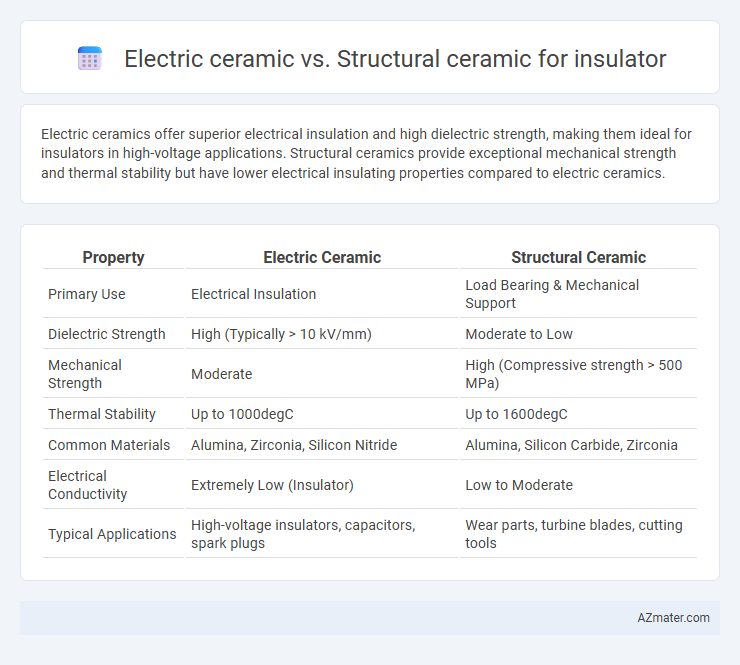Electric ceramics offer superior electrical insulation and high dielectric strength, making them ideal for insulators in high-voltage applications. Structural ceramics provide exceptional mechanical strength and thermal stability but have lower electrical insulating properties compared to electric ceramics.
Table of Comparison
| Property | Electric Ceramic | Structural Ceramic |
|---|---|---|
| Primary Use | Electrical Insulation | Load Bearing & Mechanical Support |
| Dielectric Strength | High (Typically > 10 kV/mm) | Moderate to Low |
| Mechanical Strength | Moderate | High (Compressive strength > 500 MPa) |
| Thermal Stability | Up to 1000degC | Up to 1600degC |
| Common Materials | Alumina, Zirconia, Silicon Nitride | Alumina, Silicon Carbide, Zirconia |
| Electrical Conductivity | Extremely Low (Insulator) | Low to Moderate |
| Typical Applications | High-voltage insulators, capacitors, spark plugs | Wear parts, turbine blades, cutting tools |
Introduction to Ceramic Insulators
Ceramic insulators, crucial for electrical and structural applications, differ primarily in their composition and functional properties. Electric ceramics, such as alumina and porcelain, provide high dielectric strength and excellent insulation for power systems. Structural ceramics emphasize mechanical durability and thermal resistance, making them ideal for load-bearing and high-stress environments in insulating components.
Overview of Electric Ceramics
Electric ceramics, commonly known as electroceramics, possess excellent dielectric properties, high resistivity, and strong insulation capabilities essential for electric insulators. These materials, such as alumina, zirconia, and silicon nitride, demonstrate superior performance in high-voltage and high-temperature environments due to their low dielectric loss and stability. In contrast to structural ceramics, which prioritize mechanical strength and toughness, electric ceramics are specifically engineered to optimize electrical insulation, dielectric breakdown resistance, and minimal conductivity.
Overview of Structural Ceramics
Structural ceramics, known for their exceptional mechanical strength and thermal stability, are widely used in insulator applications requiring durability under high stress and temperature conditions. These ceramics, including alumina, silicon carbide, and zirconia, offer high fracture toughness and resistance to wear and corrosion, making them ideal for structural support in electrical insulators. Unlike electric ceramics optimized for dielectric properties, structural ceramics prioritize mechanical integrity to ensure long-term reliability in harsh operating environments.
Key Material Properties Comparison
Electric ceramics used in insulators exhibit high dielectric strength, low electrical conductivity, and excellent thermal stability, making them ideal for preventing electrical discharges. Structural ceramics prioritize mechanical properties such as high fracture toughness, compressive strength, and wear resistance to withstand physical stresses in insulating components. Both types rely on materials like alumina and silicon carbide, but electric ceramics emphasize electrical insulation performance while structural ceramics focus on durability and mechanical integrity.
Dielectric Performance Analysis
Electric ceramics exhibit superior dielectric performance with high permittivity and low dielectric loss, making them ideal for insulating applications requiring efficient energy storage and minimal signal attenuation. Structural ceramics, while possessing excellent mechanical strength and thermal stability, generally have lower dielectric constants and higher dielectric losses compared to electric ceramics, limiting their effectiveness in high-frequency insulation. Dielectric performance analysis shows electric ceramics outperform structural ceramics in breakdown voltage and dielectric reliability under varying environmental conditions.
Mechanical Strength and Durability
Electric ceramics used in insulators exhibit high dielectric strength and excellent electrical insulation but typically have lower mechanical strength compared to structural ceramics. Structural ceramics offer superior mechanical strength and durability, making them ideal for applications requiring resistance to mechanical stress and harsh environments. The choice depends on balancing electrical insulation needs with mechanical load demands, as structural ceramics better withstand physical impact while electric ceramics ensure optimal electrical performance.
Applications in Electrical Systems
Electric ceramics, such as alumina and steatite, are primarily used in electrical systems as insulators due to their excellent dielectric strength and low electrical conductivity, making them ideal for components like spark plugs, capacitors, and insulator discs in high-voltage transmission lines. Structural ceramics, including silicon carbide and zirconia, offer enhanced mechanical strength and thermal resistance, suitable for applications requiring both electrical insulation and durability under mechanical stress, such as in circuit breakers, insulator supports, and mechanical housings in power equipment. The choice between electric and structural ceramics depends on the specific electrical, thermal, and mechanical requirements within power generation, distribution, and electronic device manufacturing.
Cost and Manufacturing Differences
Electric ceramics used for insulators prioritize high dielectric strength and electrical insulation, resulting in materials like alumina and porcelain with relatively moderate manufacturing costs due to established sintering and glazing processes. Structural ceramics emphasize mechanical strength and fracture toughness, often involving advanced compositions such as silicon carbide or zirconia, which increases production complexity and costs through precision machining and specialized sintering techniques. Cost differences arise primarily from raw material expenses, manufacturing challenges, and required performance characteristics, with electric ceramics generally being more cost-effective for large-scale insulator production.
Environmental Resistance and Longevity
Electric ceramics, commonly made of alumina or porcelain, exhibit superior environmental resistance due to their high dielectric strength and excellent insulation properties, effectively withstanding moisture, temperature fluctuations, and chemical exposure. Structural ceramics, such as silicon carbide or zirconia, offer enhanced mechanical strength and fracture toughness, contributing to increased longevity under mechanical stress and thermal shock conditions. Both types are crucial in insulator applications, where electric ceramics excel in electrical insulation and structural ceramics provide durability against harsh environmental and mechanical challenges.
Selection Criteria for Insulator Ceramics
Electric ceramics for insulators prioritize high dielectric strength, low dielectric loss, and excellent electrical insulation properties to withstand voltage stress and prevent current leakage. Structural ceramics emphasize mechanical toughness, fracture resistance, and thermal stability to endure physical loads and harsh environmental conditions. Selection criteria for insulator ceramics must balance electrical performance with mechanical durability, thermal expansion compatibility, and environmental resistance based on application-specific requirements.

Infographic: Electric ceramic vs Structural ceramic for Insulator
 azmater.com
azmater.com